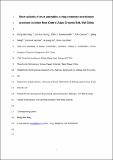Short episodes of crust generation during protracted accretionary processes
Abstract
Accretionary orogens are major sites of generation of continental crust but the spatial and temporal distribution of crust generation within individual orogens remains poorly constrained. Paleozoic (∼540–270 Ma) granitic rocks from the Alati, Junggar and Chinese Tianshan segments of the Central Asian Orogenic Belt (CAOB) have markedly bimodal age frequency distributions with peaks of ages at ∼400 Ma and 280 Ma for the Altai segment, and ∼430 Ma and 300 Ma for the Junggar and Chinese Tianshan segments. Most of the magma was generated in short time intervals (∼20–40 Ma), and variations in magma volumes and in Nd–Hf isotope ratios are taken to reflect variable rates of new crust generation within a long-lived convergent plate setting. The Junggar segment is characterized by high and uniform Nd–Hf isotope ratios (εNd(t) = +5 to +8; zircon εHf(t) = +10 to +16) and it appears to have formed in an intra-oceanic arc system. In the Altai and Chinese Tianshan segments, the Nd–Hf isotope ratios (εNd(t) = −7 to +8; zircon εHf(t) = −16 to +16) are lower, although they increase with decreasing age of the rock units. The introduction of a juvenile component into the Chinese Tianshan and Altai granitic rocks appears to have occurred in continental arc settings and it reflects a progressive reduction in the contributions from old continental lower crust and lithospheric mantle. Within the long-lived convergent margin setting (over ∼200 Ma), higher volumes of magma, and greater contributions of juvenile material, were typically emplaced over short time intervals of ∼20–40 Ma. These intervals were associated with higher Nb/La ratios, coupled with lower La/Yb ratios, in both the mafic and granitic rocks, and these episodes of increased magmatism from intraplate-like sources are therefore thought to have been in response to lithospheric extension. The trace element and Nd–Hf isotope data, in combination with estimates of granitic magma volumes, highlight that crust generation rates are strongly non-uniform within long-lived accretionary orogens. The estimated crust generation rates range from ∼0.1 to ∼40 km3/km/Ma for the Paleozoic record of the CAOB, and only comparatively short (20–40 Ma) periods of elevated magmatic activity had rates similar to those for modern intra-oceanic and continental arcs.
Citation
Tang , G-J , Chung , S-L , Hawkesworth , C J , Cawood , P A , Wang , Q , Wyman , D A , Xu , Y-G & Zhao , Z-H 2017 , ' Short episodes of crust generation during protracted accretionary processes ' , Earth and Planetary Science Letters , vol. 464 , pp. 142-154 . https://doi.org/10.1016/j.epsl.2017.02.022
Publication
Earth and Planetary Science Letters
Status
Peer reviewed
ISSN
0012-821XType
Journal article
Description
This study was supported by funding from the Strategic Priority Research Program (B) of the Chinese Academy of Sciences (grant nos. XDB03010600 and XDB18020204), the National Natural Science Foundation of China (grant nos. 41202041, 41630208 and 41673033), the Key Program of the Chinese Academy of Sciences (QYZDJ-SSW-DQC026), the DREAM Program of China (No. 2016YFC0600407), talent project of Guangdong Province (2014TX01Z079), and GIG–CAS 135 project 135TP201601. PAC and CJH acknowledge support from the Natural Environment Research Council (grant NE/J021822/1). The senior author thanks the grant from the NSC, Taiwan, which supported his one-year academic visit at the NTU. This is contribution no. IS-2352 from GIG–CAS.Collections
Items in the St Andrews Research Repository are protected by copyright, with all rights reserved, unless otherwise indicated.

